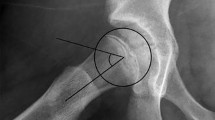Abstract
Femoroacetabular impingement due to metaphyseal prominence is associated with the slippage in patients with slipped capital femoral epiphysis (SCFE), but it is unclear whether the changes in femoral metaphysis morphology are associated with range of motion (ROM) changes or type of impingement. We asked whether the femoral head-neck junction morphology influences ROM analysis and type of impingement in addition to the slip angle and the acetabular version. We analyzed in 31 patients with SCFE the relationship between the proximal femoral morphology and limitation in ROM due to impingement based on simulated ROM of preoperative CT data. The ROM was analyzed in relation to degree of slippage, femoral metaphysis morphology, acetabular version, and pathomechanical terms of “impaction” and “inclusion.” The ROM in the affected hips was comparable to that in the unaffected hips for mild slippage and decreased for slippage of more than 30°. The limitation correlated with changes in the metaphysic morphology and changed acetabular version. Decreased head-neck offset in hips with slip angles between 30° and 50° had restricted ROM to nearly the same degree as in severe SCFE. Therefore, in addition to the slip angle, the femoral metaphysis morphology should be used as criteria for reconstructive surgery.





Similar content being viewed by others
References
Boles CA, el-Khoury GY. Slipped capital femoral epiphysis. Radiographics. 1997;17:809–823.
Boyer DW, Mickelson MR, Ponseti IV. Slipped capital femoral epiphysis: long-term follow-up study of one hundred and twenty-one patients. J Bone Joint Surg Am. 1981;63:85–95.
Carney BT, Weinstein SL, Noble J. Long-term follow-up of slipped capital femoral epiphysis. J Bone Joint Surg Am. 1991;73:667–674.
Debrunner HU. Orthopädisches Diagnostikum. Stuttgart, Germany: Georg Thieme Verlag; 1973.
Futami T, Kasahara Y, Suzuki S, Seto Y, Ushikubo S. Arthroscopy for slipped capital femoral epiphysis. J Pediatr Orthop. 1992;12:592–597.
Gelberman RH, Cohen MS, Shaw BA, Kasser JR, Griffin PP, Wilkinson RH. The association of femoral retroversion with slipped capital femoral epiphysis. J Bone Joint Surg Am. 1986;68:1000–1007.
Hansen EH. Measurement and description of joint mobility by the neutral zero method [in Danish]. Ugeskr Laeger. 1975;137:2822–2825.
Ito K, Minka MA 2nd, Leunig M, Werlen S, Ganz R. Femoroacetabular impingement and the cam-effect: a MRI-based quantitative anatomical study of the femoral head-neck offset. J Bone Joint Surg Br. 2001;83:171–176.
Jones JR, Paterson DC, Hillier TM, Foster BK. Remodelling after pinning for slipped capital femoral epiphysis. J Bone Joint Surg Br. 1990;72:568–573.
Key J. Epiphyseal coxa vara or displacement of the epiphysis of the femur in adolescence. J Bone Joint Surg. 1926;8:53–57.
Kordelle J, Richolt JA, Millis M, Jolesz FA, Kikinis R. Development of the acetabulum in patients with slipped capital femoral epiphysis: a three-dimensional analysis based on computed tomography. J Pediatr Orthop. 2001;21:174–178.
Leunig M, Casillas MM, Hamlet M, Hersche O, Notzli H, Slongo T, Ganz R. Slipped capital femoral epiphysis: early mechanical damage to the acetabular cartilage by a prominent femoral metaphysis. Acta Orthop Scand. 2000;71:370–375.
Moreau MJ. Remodelling in slipped capital femoral epiphysis. Can J Surg. 1987;30:440–442.
Murray RO. The aetiology of primary osteoarthritis of the hip. Br J Radiol. 1965;38:810–824.
Ozonoff MB. The hip. In: Bralow L, ed. Pediatric Orthopedic Radiology. 2nd ed. Philadelphia, PA: WB Saunders; 1992:293–300.
Rab GT. The geometry of slipped capital femoral epiphysis: implications for movement, impingement, and corrective osteotomy. J Pediatr Orthop. 1999;19:419–424.
Richolt JA, Teschner M, Everett PC, Millis MB, Kikinis R. Impingement simulation of the hip in SCFE using 3D models. Comput Aided Surg. 1999;4:144–151.
Schai PA, Exner GU, Hansch O. Prevention of secondary coxarthrosis in slipped capital femoral epiphysis: a long-term follow-up study after corrective intertrochanteric osteotomy. J Pediatr Orthop B. 1996;5:135–143.
Southwick WO. Osteotomy through the lesser trochanter for slipped capital femoral epiphysis. J Bone Joint Surg Am. 1967;49:807–835.
Stanitski CL, Woo R, Stanitski DF. Femoral version in acute slipped capital femoral epiphysis. J Pediatr Orthop B. 1996;5:74–76.
Wilson PD, Jacobs B, Schecter L. Slipped capital femoral epiphysis: an end-result study. J Bone Joint Surg Am. 1965;47:1128–1145.
Acknowledgments
We thank Christoph Zilkens, MD and Marcel Dudda, MD for their help editing the manuscript and Carl P. Kolvenbach, MD for support in analysis of the data.
Author information
Authors and Affiliations
Corresponding author
Additional information
Each author certifies that he or she has no commercial associations (eg, consultancies, stock ownership, equity interest, patent/licensing arrangements, etc) that might pose a conflict of interest in connection with the submitted article.
Each author certifies that his or her institution has approved the human protocol for this investigation, that all investigations were conducted in conformity with ethical principles of research, and that informed consent for participation in the study was obtained.
About this article
Cite this article
Mamisch, T.C., Kim, YJ., Richolt, J.A. et al. Femoral Morphology Due to Impingement Influences the Range of Motion in Slipped Capital Femoral Epiphysis. Clin Orthop Relat Res 467, 692–698 (2009). https://doi.org/10.1007/s11999-008-0477-z
Received:
Accepted:
Published:
Issue Date:
DOI: https://doi.org/10.1007/s11999-008-0477-z




